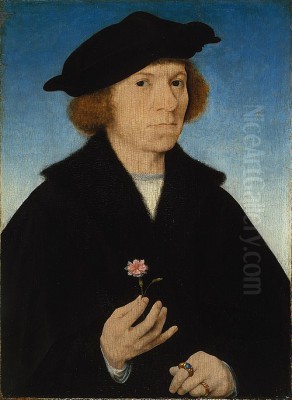
Joos van Cleve stands as one of the most significant and prolific painters active in Antwerp during the first half of the 16th century. Flourishing between approximately 1485 and his death in 1540 or 1541, he navigated a period of immense artistic transition. His extensive body of work, encompassing both devotional religious scenes and insightful portraits, reveals a masterful synthesis of the rich traditions of Early Netherlandish painting with the burgeoning influences of the Italian Renaissance. Operating a large and highly productive workshop, Van Cleve catered to a diverse clientele, ranging from local merchants and religious institutions to international royalty, solidifying Antwerp's reputation as a major European artistic center.
Origins and Emergence in Antwerp
Believed to have been born Joos van der Beke around 1485, the artist hailed from the Lower Rhenish region of Cleves, or possibly the nearby town of Xanten. This origin is reflected in the name "van Cleve," which he adopted later in his career. While details of his early training remain speculative, his formative years likely exposed him to the artistic currents prevalent in the region, which bordered the vibrant artistic centers of the Low Countries.
A pivotal moment in his early career involved his participation as an assistant in the workshop of Jan Joest, a respected painter from Kalkar. Between 1505 and 1508, Van Cleve contributed to the creation of the imposing high altarpiece for the St. Nicolai church in Kalkar. Art historians identify his hand in several panels, notably a depiction of the Raising of Lazarus, which intriguingly includes what is believed to be an early self-portrait of the young artist among the onlookers. This collaboration provided invaluable experience working on a large-scale, prestigious commission.
By 1511, Joos van Cleve had established himself in Antwerp, the rapidly expanding economic and cultural hub of the Southern Netherlands. In that year, he was officially registered as a master painter in the prestigious Guild of Saint Luke, the city's governing body for artists and craftsmen. This membership marked his formal entry into the competitive Antwerp art scene and granted him the right to establish his own workshop and take on apprentices.
A Synthesis of Styles: North and South
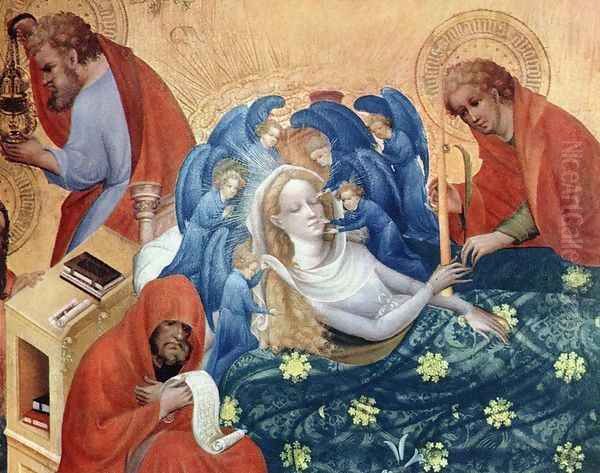
Joos van Cleve's artistic identity is characterized by his remarkable ability to absorb and integrate diverse stylistic influences. His work is deeply rooted in the meticulous realism, rich color, and complex symbolism pioneered by earlier Netherlandish masters. Echoes of Jan van Eyck's luminous detail, Rogier van der Weyden's emotional intensity, and the serene compositions of Gerard David can be discerned in his paintings. He possessed a profound technical mastery, evident in the delicate rendering of textures, fabrics, and facial features.
Simultaneously, Van Cleve was highly receptive to the artistic innovations emanating from Italy. While there is no evidence he ever travelled south of the Alps himself, Antwerp's status as an international port meant that Italian artworks, prints, and ideas circulated widely. He demonstrated a particular affinity for the grace, compositional harmony, and subtle modeling associated with Leonardo da Vinci and his Milanese followers. This led some later commentators to dub him the "Leonardo of the North," acknowledging his success in adapting Italianate elegance to a Northern European sensibility.
He also absorbed lessons from contemporaries. The influence of Joachim Patinir, an Antwerp pioneer of landscape painting, is evident in the expansive, atmospheric vistas that often form the backdrops of Van Cleve's religious scenes. His ability to blend Patinir's specialized landscape skills with his own figure painting demonstrates a collaborative spirit common in Antwerp workshops. This fusion resulted in a distinctive style: technically brilliant, chromatically sensitive, and compositionally sophisticated, appealing to the refined tastes of his patrons.
Masterpieces of Religious Devotion
Religious painting formed the core of Joos van Cleve's output. His workshop produced numerous altarpieces and smaller devotional panels catering to both church commissions and the burgeoning private market. One of his most celebrated early works is the Death of the Virgin altarpiece, likely created around 1515. Originally commissioned for a Cologne family, its powerful emotional resonance and masterful execution led to the artist initially being identified by art historians as the "Master of the Death of the Virgin," before his true identity was firmly established. The work showcases his skill in complex group compositions and dramatic narrative.
Another highly popular theme was the Holy Family. Van Cleve and his workshop produced many variations on this subject, often depicting the Virgin Mary, Christ Child, and Saint Joseph in tender, domestic settings. These works combined devotional intimacy with rich detail and often incorporated symbolic elements, such as fruit or flowers, alluding to theological concepts. The demand for these paintings underscores their appeal to contemporary piety and the desire for accessible religious imagery.
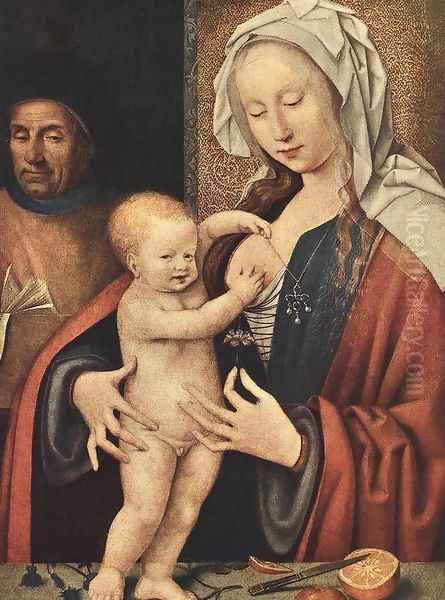
The Madonna of the Cherries is a prime example of Van Cleve's mature style, beautifully integrating Northern detail with Italianate grace. The composition, featuring the Virgin offering cherries (symbolizing the sweetness of Paradise or the blood of Christ) to the Child, is set against a backdrop that combines decorative Renaissance architectural elements with a deep, Patinir-esque landscape. The soft modeling of the figures, particularly the sfumato-like treatment of flesh tones, clearly reflects the influence of Leonardo.
Other significant religious works include various depictions of the Adoration of the Magi, showcasing his ability to handle elaborate costumes and exotic details, and The Annunciation. In panels like The Annunciation housed in the Metropolitan Museum of Art, New York, Van Cleve demonstrates his awareness of earlier Netherlandish iconography, sometimes referencing specific motifs, like the bed canopy design, found in works by Jan van Eyck, while updating them within his own stylistic framework. A rare foray into large-scale nudes, The Last Judgment, suggests an engagement with Italian models for depicting the human form, possibly influenced by prints after artists like Michelangelo or Raphael, though filtered through his Northern training.
Insightful Portraiture
Alongside his religious output, Joos van Cleve was a highly sought-after portraitist. He possessed a keen ability to capture not only the physical likeness of his sitters but also a sense of their presence and status. His portraits are characterized by their clarity, refined execution, and often, a direct yet dignified engagement with the viewer. He painted members of European royalty, aristocracy, and wealthy merchant families.
Among his most famous sitters was King Francis I of France and his second wife, Eleanor of Austria. The surviving portraits of the royal couple are exemplary of his courtly style, combining meticulous detail in costume and jewelry with a sensitive portrayal of individual character. These commissions highlight Van Cleve's international reputation and his access to the highest echelons of society.
He also painted King Christian II of Denmark. This portrait, commissioned by the Italian merchant Niccolò Bellogio in Antwerp, demonstrates Van Cleve's innovative approach to the genre. He often included the sitter's hands, using gestures to add dynamism and psychological depth. The depiction of Christian II, possibly featuring a clenched fist, adds a layer of intensity and character beyond a simple recording of features. His portraits of Antwerp merchants, such as Joris Zeveleer, provide valuable visual records of the city's prosperous elite.
The Antwerp Workshop: Production and Proliferation
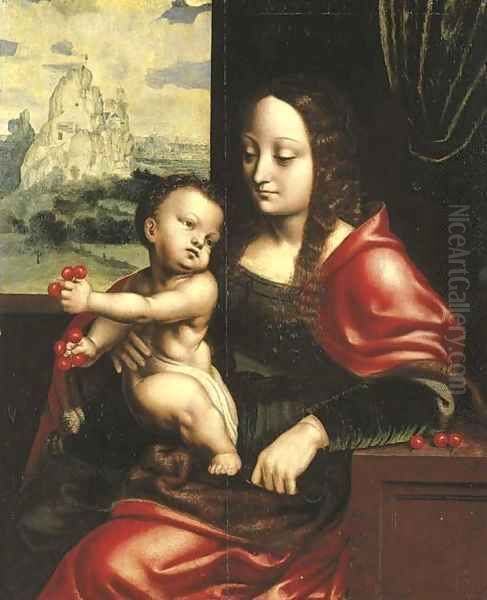
Joos van Cleve operated one of the largest and most successful painting workshops in Antwerp during his time. Guild records indicate he employed numerous apprentices and assistants throughout his career. At least five named pupils are documented, including Claes van Bruggen, whom he took on in 1516. His own son, Cornelis van Cleve (c. 1520-1567), also trained and worked as a painter, initially in his father's style, though Cornelis later developed mental health issues, leading to the nickname "Sotte Cleef" (Mad Cleef) and some historical confusion between the two artists' oeuvres.
The workshop structure was crucial to meeting the high demand for Van Cleve's work. It allowed for efficient production, particularly of popular compositions like the Holy Family or the Madonna and Child. Assistants would likely have prepared panels, transferred designs, painted backgrounds or secondary figures, and produced replicas or variants under the master's supervision. While this system ensured a wide dissemination of Van Cleve's style, it also complicates matters of attribution for art historians today, who must carefully distinguish between works executed entirely by the master, those with workshop participation, and full workshop copies.
The sheer volume of paintings attributed to Joos van Cleve and his workshop – estimated at over 300 works – attests to his commercial success and the efficiency of his operation. This prolific output significantly contributed to the visual culture of Antwerp and beyond, making his style widely recognizable and influential. His workshop practices were typical of the period in Antwerp, where artists like Quentin Matsys and later Pieter Coecke van Aelst also ran large, commercially oriented studios.
Patronage, Networks, and Influence
Joos van Cleve's success was built upon a broad and diverse network of patrons and connections. Locally in Antwerp, he received commissions from religious institutions, such as churches and convents (like the commission involving portraits for the St. Anne's convent, likely facilitated by Italian patrons), and from the city's powerful guilds, including his own Guild of Saint Luke. Wealthy merchants, both local Netherlanders like Joris Zeveleer and members of the influential foreign communities, were significant clients.
The Italian merchant community in Antwerp played a particularly important role. These expatriates, involved in international trade and finance, were sophisticated patrons who appreciated Van Cleve's ability to blend Northern traditions with the Italian styles they knew from home. They commissioned devotional works and portraits, acting as cultural intermediaries and helping to spread his fame. The commission for the portrait of King Christian II by Niccolò Bellogio is a case in point.
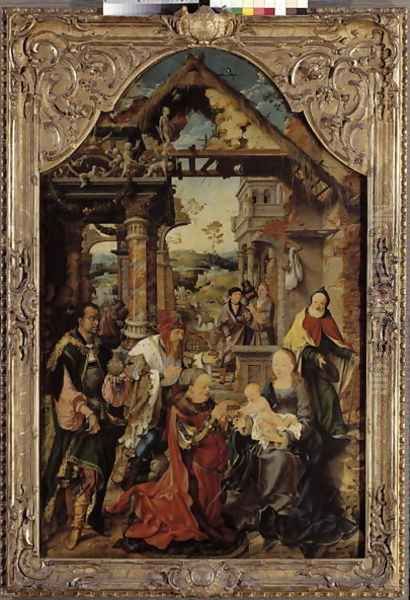
His reputation extended well beyond Antwerp. Clients came from other cities in the Netherlands, such as The Hague and Delft. His works were also highly sought after in German cities like Cologne, Nuremberg, and Leipzig, indicating strong trade and cultural links. The presence of major works like the Death of the Virgin in Cologne from an early date confirms this German connection. The popularity and replication of compositions like the Holy Family in both Germany and Italy further underscore his international reach.
His interactions with fellow artists were also significant. The early collaboration with Jan Joest has already been noted. His relationship with Joachim Patinir appears to have been one of mutual respect and likely collaboration, particularly in the integration of figures and landscapes. While direct contact with Albrecht Dürer during the latter's visit to Antwerp in 1520-21 isn't definitively documented, Van Cleve was certainly aware of the German master's work, and some stylistic affinities have been noted by scholars, likely absorbed through prints or shared artistic circles. He was a central figure within the vibrant Antwerp artistic milieu, interacting professionally with contemporaries like Matsys, Gossaert, and Coecke van Aelst.
Technical Skill and Artistic Traits
A closer examination of Joos van Cleve's works reveals specific technical hallmarks. Infrared reflectography, used to study the underdrawings beneath the paint layers, often shows detailed and confident preparatory sketches. In works like The Virgin and Child, the underdrawing reveals multiple outlines as the artist refined the composition, along with the use of parallel and cross-hatching, particularly in drapery, to establish volume and shadow. This careful planning underlies the polished finish of his paintings.
His handling of paint is characterized by a smooth application, often building up thin layers or glazes to achieve luminosity and depth of color, a technique inherited from Early Netherlandish masters. His palette could range from rich, jewel-like tones, especially in depictions of luxurious fabrics and draperies, to more subtle, harmonious color schemes. The influence of Leonardo is sometimes apparent in the soft transitions between light and shadow (sfumato), particularly in faces and flesh tones, lending his figures a gentle, idealized quality.
Van Cleve often included small, meticulously rendered details that add richness and symbolic meaning to his compositions – flowers with specific connotations, carefully depicted objects, or glimpses into distant landscapes. His inclusion of self-portraits, whether the early one in the Kalkar altarpiece or potential later appearances as bystanders in religious narratives, offers a personal touch and asserts his presence within the work, a practice not uncommon among artists of the period.
Reception, Controversy, and Legacy
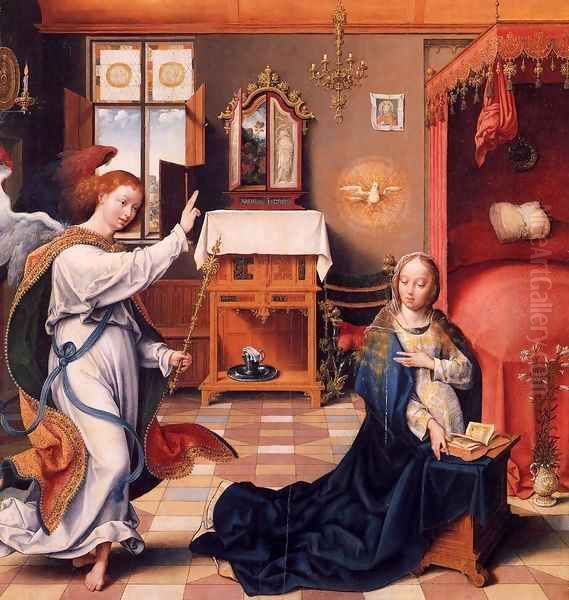
Despite his considerable success during his lifetime, Joos van Cleve's fame waned after his death. For centuries, his work was often misattributed or overlooked, partly due to the confusion with the "Master of the Death of the Virgin" moniker and potentially overshadowed by the dramatic story of his son, Cornelis. It was only in the late 19th and early 20th centuries that art historians began to systematically reconstruct his oeuvre and re-evaluate his significance.
Modern scholarship recognizes him as a pivotal figure in Antwerp painting, but his precise standing remains a subject of nuanced discussion. Some critics argue that while technically brilliant and commercially successful, he was perhaps less innovative than contemporaries like Jan Gossaert, who travelled to Italy and more radically transformed his style, or Joachim Patinir, who pioneered a new genre. Van Cleve's absorption of Italian influence is seen as more adaptive than revolutionary, skillfully blending it with his Northern heritage rather than forging a completely new path.
The extensive workshop production also presents ongoing challenges for connoisseurship, requiring careful analysis to distinguish the master's hand from that of his collaborators. However, this very workshop activity was crucial to his impact, disseminating his popular compositions widely and influencing subsequent generations of Antwerp painters.
Today, Joos van Cleve is appreciated for his exceptional technical skill, his sensitivity to color and light, and his role as a key synthesizer of Northern and Southern artistic trends in the dynamic environment of early 16th-century Antwerp. His works, found in major museums worldwide, offer compelling insights into the religious devotion, social structures, and artistic exchanges of his time. He remains a testament to the quality and vibrancy of the Antwerp school during its golden age.
Conclusion
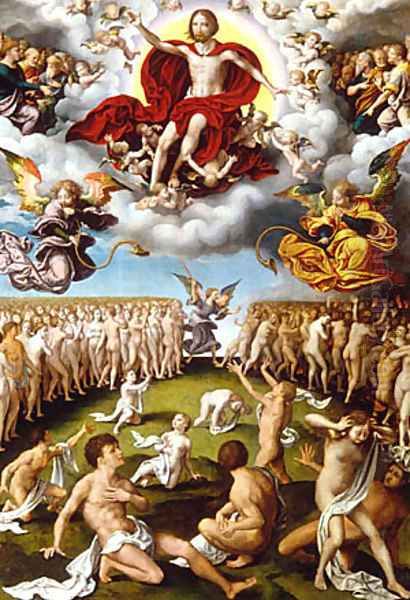
Joos van Cleve navigated the complex artistic landscape of the early Northern Renaissance with remarkable skill and adaptability. From his early training and collaboration with Jan Joest to his establishment as a leading master in Antwerp, he consistently demonstrated technical prowess and a keen understanding of market demands. His ability to fuse the detailed realism of the Netherlandish tradition with the grace and harmony of the Italian Renaissance created a highly appealing and influential style. Through his prolific workshop, his devotional paintings and insightful portraits reached a wide audience across Europe, cementing his reputation and contributing significantly to Antwerp's status as a preeminent artistic center. While subject to historical fluctuations in fame and ongoing scholarly debate regarding attribution and innovation, Joos van Cleve remains an indispensable figure for understanding the rich tapestry of art in the Low Countries during a period of profound transformation.